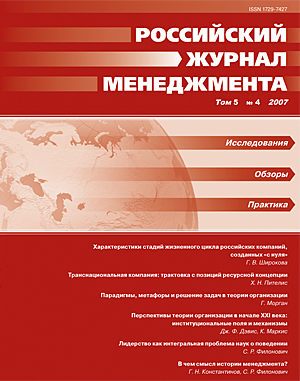The Multinational Enterprise: A Resource-Based View
Abstract
We build on the work of Edith Penrose to develop a resourcebased perspective to the theory of the multinational enterprise (MNE). We suggest that transborder geographical diversification is the result of endogenous growth processes, firms’ “productive opportunity”, limits to domestic expansion, failed or missing markets, perceived differential opportunities abroad, and oligopolistic interaction. The choice of institutional mode (foreign direct investment, subcontracting, licensing or exporting) is due to the same factors, but also the differential control and/or transaction cost attributes of different modes.
Downloads
References
REFERENCES IN LATIN ALPHABET
Downloads
Published
How to Cite
Issue
Section
License
Articles of the Russian Management Journal are open access distributed under the terms of the License Agreement with Saint Petersburg State University, which permits to the authors unrestricted distribution and self-archiving free of charge.





